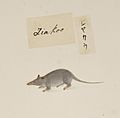Asian house shrew facts for kids
Quick facts for kids Asian House Shrew |
|
|---|---|
 |
|
| Conservation status | |
| Scientific classification | |
| Genus: |
Suncus
|
| Species: |
murinus
|
 |
|
| Asian house shrew range (blue — native, red — introduced) |
|
| Synonyms | |
|
Sorex murinus Linnaeus, 1766 |
|
The Asian house shrew (Suncus murinus) is a type of shrew. It is native to South and Southeast Asia. It is the largest type of shrew. It is a least concern species. It has been introduced in several West Asian and East African countries. It is an invasive species.
Contents
Description
The Asian house shrew is 100 mm and 150 mm long. An adult female weighs between 23.5 g and 82.0 g. An adult male weighs from 33.2 g to 147.3 g. It has short, dense fur. It is mid-grey to brownish-grey color.
Distribution and Habitat
The Asian house shrew is native to South and Southeast Asia. It was introduced to eastern Africa, Arabia, Madagascar, the Philippines and other islands in the Indian and Pacific Oceans.
It is found in forests, agricultural lands, and in places with lots of human activity. It is also found in many houses and businesses. It is mainly a terrestrial animal.
Feeding
It is mainly an insectivore. It eats insects, mammals, plants and human food.
Behaviour
It very adaptable species. They are nocturnal. They are thought to mainly live by themselves.
Reproduction
They breed throughout the year. It gives birth to one to eight young ones. The gestation period is one month. It starts breeding when it is around one year old.
Relationships with humans
It helps to control the population of many pests. It is an invasive species. They compete with many types of plants and animals. It is also a pest. It can damage food and other materials found in homes and businesses.
Images for kids
See also
 In Spanish: Musaraña casera para niños
In Spanish: Musaraña casera para niños






